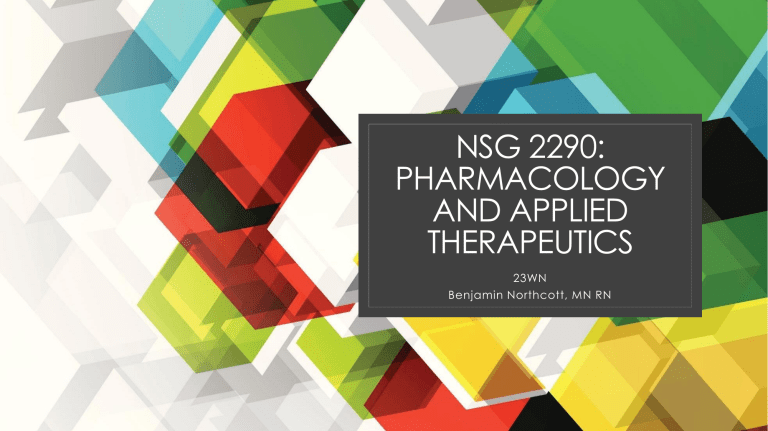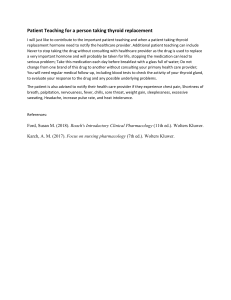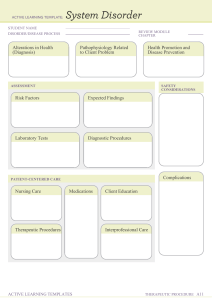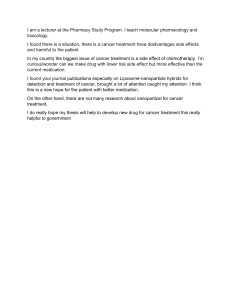
NSG 2290: PHARMACOLOGY AND APPLIED THERAPEUTICS 23WN Benjamin Northcott, MN RN COURSE OVERVIEW Course Documents Course Outline Course Guide My Contact Info Weekly Readings and Topics Assessments – Due Dates Medications, Labs, Other Tests Textbooks Assessments - Details Announcements Modules/Resources PowerPoints Supplemental Assignments/Exams Lecture & Activities Attendance and Breaks Classroom Contract BYOD CANVAS and Classroom CH 1: INTRO TO DRUGS Karch, A. M. (2020). Focus on nursing pharmacology (8th ed.). Wolters Kluwer. Key Terms ◦ Drugs ◦ Chemicals introduced into the body that cause some sort of change or effect. ◦ Pharmacology ◦ The study of biological effects** of chemicals. ◦ Pharmacotherapeutics (clinical pharmacology) ◦ The branch of pharmacology that uses drugs to treat, prevent, and diagnose disease. ◦ Pharmacodynamics – how drugs affect the body ◦ Pharmacokinetics – how the body deals with drugs **Some drug effects are helpful (therapeutic); others are undesirable or potentially dangerous (side effects or adverse effects) Drug Names Chemical Name Exact description of the chemical or molecule N-acetyl-paraaminophenol L-Thyroxine (T4) Generic Name Original designation when running trials and applying for approval acetaminophen levothyroxine pantoprazole Trade/Brand Name Name used for marketing of an approved drug Tylenol, Tempra, Pediatrix Pantoloc, Tecta Synthroid, Eltroxin 5-(difluoromethoxy)2-[(3,4dimethoxypyridin-2yl)methylsulfinyl]benz imidazol-1-ide Sources of Drug Information ◦ Drug Labels ◦ Drug labels have specific information that identifies a specific drug ◦ Understanding how to read a drug label is essential ◦ Package Inserts ◦ Prepared by the manufacturer ◦ Contains all of the chemical and study information that led to the drug’s approval ◦ Can be difficult to understand and read ◦ Reference Books ◦ Physician’s Drug Reference (PDR) ◦ CPS (Compendium of Pharmaceuticals and Specialties) ◦ AMA Drug Evaluations ◦ Lippincott’s Nursing Drug Guide (LNDG) ◦ Many Others ◦ Textbooks ◦ Journals ◦ Internet ◦ Issue: Unreliable Info (Example) Where Do Drugs Come From? Plants (molds, fungi, etc.) •Originally used directly by botanists and apothecaries, doctors and surgeons •Examples: digitalis, opiates •Now, drug companies often used a synthetically derived version of the active chemical found in the plant •Many herbs and plants still being used as complementary or alternative therapies Animals Inorganic Compounds SYNTHETIC SOURCES •Replaces human chemicals not produced due to disease or genetic problems •Examples: insulin, thyroxine, growth hormone •Again, many are now being produced synthetically •Natural elements that have therapeutic effects •Examples: iron, aluminum, gold •Genetic Engineering •Use genetically altered bacteria to produce desired drug chemicals •Chemical Engineering •Alter the drug chemicals to increase their effectiveness and/or reduce adverse effects Drug Approval Process Story of Thalidomide Drug Classifications Therapeutic Classification: based on what disease/condition the drug treats. Controlled Substances: rated by potential risk for dependence or abuse. Pharmacologic Classification: based on the mechanism of action and/or effects caused by the drug. Pregnancy Classification: Has been removed from most drug guides, as was found to be confusing. Was used to determine risks to developing fetus and/or breastfeeding child. Prescription vs. Over-theCounter Generics: cheaper as they are mass produced after the research/marketing process has been completed. Prototypes ◦ Due to advances in chemical and genetic engineering, there are now large numbers of drugs in a single class which all derive from an original version, or prototype. ◦ Prototype drugs are sometimes referred to as 1st generation drugs. Nurse’s Role in Drug Therapy Administer drugs Assess drug effects Intervene to make drug regimen more tolerable Provide patient teaching about drugs and drug regimens Monitor the overall patient care plan to prevent drug errors CH 2: DRUGS AND THE BODY Karch, A. M. (2020). Focus on nursing pharmacology (8th ed.). Wolters Kluwer. Pharmacodynamics: The study of the interactions between the chemical components of the living organisms and foreign chemicals. The way a drug affects the body. Drug Actions 01 02 03 04 replace or act as substitute for missing chemicals (ex. insulin) increase or stimulate cellular activities (ex. furosemide increases urine output) depress or slow cellular activities (ex. morphine decreases pain signal transmission) interfere with the functioning of “foreign” cells (ex. antibiotics) Receptor Sites ◦ Specific areas on cell membranes that react to stimulation by certain chemicals ◦ When stimulated – produces an effect or change within the cell ◦ Different cells have different receptor sites ◦ Different cells react in different ways to receptor site stimulation ◦ Some drugs affect enzymes associated with receptor sites, rather than the membrane receptor site directly ◦ Selective Toxicity: the degree to which a drug targets and interacts with receptors on “foreign” cells only without affecting healthy human cells Receptor Site Competition More than one chemical can compete for and affect the cells functions at the same time Pharmacokinetics: The study of how drugs enter the body (absorption), reach the site of action (distribution), change from one form to another for use (metabolism), and exit the body (excretion). The way the body deals with the drug. Pharmacokinetics ◦ Critical Concentration (or Therapeutic Concentration) ◦ The amount of drug needed to produce a therapeutic effect ◦ Loading Dose ◦ Higher initial dose than that usually used for treatment ◦ Used to reach the critical concentration faster ◦ Subsequent maintenance doses will be lower ◦ Onset of Action ◦ How long it takes to see the therapeutic effect begin to occur ◦ Dynamic Equilibrium ◦ Actual concentration that the drug reaches in the body ◦ Balance between processes of absorption, distribution, metabolism, and excretion ◦ Peak ◦ How long it takes to see the maximum effect of the drug ◦ Half-Life ◦ The time it takes for the amount of drug in the body to decrease to one-half the peak level ◦ Duration ◦ How long the therapeutic effects of the drug will last Pharmacokinetics Absorption Distribution Metabolism • affected by route of administration • oral meds may be affected by food in stomach • oral meds often extensively metabolized by the liver (first pass effect) • Passive diffusion vs. active transport • the movement of a drug to the body’s tissues and cells • protein binding • blood-brain barrier (lipidsoluble drugs) • body conditions • placenta and breast milk • liver is the most important site for metabolism • liver breaks drug down into metabolites • helps prevent medications from causing adverse effects Excretion • drugs removed from the body • most commonly excreted in urine Absorption: What happens to a drug from the time it is introduced to the body until it reaches the circulating fluids and tissues Factors Influencing Drug Effects Modifiable Factors • weight • psychological • environmental • accumulation effects Non-modifiable Factors • age • biological sex • physiological • pathological • genetic • immunological • tolerance Interactions • drug-drug • drug-alternative therapy product • drug-food • drug-lab tests Other Factors Tolerance Dependence ◦ Drug no longer causes same effect or same level of effect ◦ Physical dependence ◦ Result: medication doses are increased over time to continue to produce the desired therapeutic effect ◦ Can result from chronic need and/or long-term use ◦ Cross-tolerance ◦ tolerance to other medications within the same drug class ◦ ex. opiates ◦ biological/physiological adaptation to the drug’s presence ◦ may suffer withdrawal symptoms if discontinued ◦ Psychological dependence ◦ medication is desired for benefits other than the intended effect(s) Acute Therapy Maintenance Therapy Types of Therapy Supplemental Therapy Palliative Therapy Supportive Therapy Prophylactic Therapy Empirical Therapy Lilley’s Pharmacology (pp. 29-30) CH 3: TOXIC EFFECTS OF DRUGS Karch, A. M. (2020). Focus on nursing pharmacology (8th ed.). Wolters Kluwer. Adverse Effects ◦ ALL drugs are potentially dangerous ◦ Adverse Effects = Undesired effects that may be unpleasant or even dangerous ◦ Drug may have other effects on the body besides the desired therapeutic effect ◦ Patient may be sensitive to the drug being given ◦ Drug’s action on the body may cause other responses that are undesired or unpleasant ◦ Patient is taking too much or too little of the drug ◦ What is the nurse’s role regarding adverse reactions? The Nurse’s Role 01 02 03 04 Watch for signs of adverse reactions Teach patients and their families what to watch for and report Provide counter measures or comfort measures for adverse effects Help patient prevent or cope in order to increase compliance with the drug therapy Adverse Reactions vs. Allergies Adverse Reactions Primary Actions • Overdose; extension of the desired effect • ex. spontaneous bleeding with anticoagulation therapy Secondary Actions • Undesired effects produced in addition to therapeutic effect • ex. antihistamines dry up secretions, but also cause drowsiness Hypersensitivity Reactions • Excessive response to primary or secondary effect of drug Allergies = antibody formation and immune response Anaphylactic Reaction • release of histamines; immediate life-threatening reactions Cytotoxic Reaction • antibodies attack antigens (drug) on receptor site, also kills cell involved • not immediate; may occur over several days Serum Sickness Reaction • antibodies cause damage by depositing in blood vessels • Symptoms: itchy rash, high fever, swollen lymph nodes, swollen/painful joints; edema on face or limbs • 1 week or more after exposure Delayed Allergic Reaction • antibodies bound to specific WBC • Symptoms: rash, hives, swollen joints • occurs hours to days after exposure Drugs can directly or indirectly cause harmful effects to many different tissues, organs, and structures in the body. Drug-Induced Tissue & Organ Damage Dermatological (Rashes, Hives, Stomatitis) Superinfections Blood Dyscrasia (bone marrow suppression) Toxicity: Unacceptable effects that can be potentially serious. Usually result in reversible or irreversible damage. Liver injury Renal injury Poisoning Hyperglycemia/Hypoglycemia Electrolyte imbalances (especially potassium) Sensory effects (ocular, auditory) Neurological effects (CNS, Parkinson-like Syndrome, Atropinelike Effects, NMS) Teratogenicity CH 4: THE NURSING PROCESS Karch, A. M. (2020). Focus on nursing pharmacology (8th ed.). Wolters Kluwer. Generic Nursing Process Assessment Data gathering History Physical assessment Holistic Nursing Diagnosis Synthesizing assessment information into diagnosis to plan care Planning/ Implementation Setting goals Desired patient outcomes Drug administration (Rights) Lifestyle Adjustment Comfort and Other Therapeutic Measures Patient/Family education Evaluation Leads to changes in assessment, diagnosis, and intervention May involve follow-up assessment, bloodwork, diagnostic imaging, etc. Should include discussion with patient Proper Drug Administration (5+ Rights) Patient* Drug* Dose* Time* Route* Documentation Reason Preparation Technique or Approach Response Others? CRNA Medication Management Standards (2021) Medication Administration Patient Identification ◦ Use at least 2 patient identifiers ◦ ID band ◦ Confirm identity with patient, family, or staff who know patient Prevention of Medication Errors ◦ Drug regimen process to be followed ◦ Checks: ◦ Nurse role ◦ Patient role ◦ Report all errors ◦ Safe Practices ISMP Canada Patient Teaching ◦ Name, dose, and action of drug ◦ Timing of administration ◦ Special storage and preparation instructions ◦ Specific OTC drugs or alternative therapies to avoid ◦ Special comfort or safety measures ◦ Specific points about drug toxicity ◦ Specific warnings about drug discontinuation See also Lilley’s Pharmacology Chapter 7 Activity Mr. Einstein is your patient today. He is a 67-year-old man. He has been admitted with pneumonia and COPD exacerbation. He is currently on 4L of O2 via nasal prongs. He has been prescribed: - Ancef 500 mg q8h IV - Flagyl 250 mg q8h PO Home Meds: - Spiriva 18 µg INH OD - Ventolin 1-2 puffs q4h PRN Using the nursing process, determine what assessments, diagnoses, plans/goals of care, nursing interventions, and evaluation criteria you would implement for Mr. Einstein. CH 5: DOSAGE CALCULATIONS Karch, A. M. (2020). Focus on nursing pharmacology (8th ed.). Wolters Kluwer. Dosing Considerations? Who is Responsible? Factors Affecting Dosage ◦ Prescriber ◦ Packaging/Preparation ◦ Orders drug ◦ Route, dose, preparation ◦ Pharmacist ◦ Route ◦ Gender ◦ Dispenses the drug ◦ Weight ◦ Preparation, dose, timing ◦ Age ◦ Nurse ◦ Administers the drug ◦ Rights of Drug Administration ◦ Often the final check before drug gets to the patient ◦ Physical condition ◦ Other drugs patient is taking CH 6: CHALLENGES TO EFFECTIVE DRUG THERAPY Karch, A. M. (2020). Focus on nursing pharmacology (8th ed.). Wolters Kluwer. Consumer Awareness Media Influence • Since 1990s, became legal to advertise prescription drugs • Everywhere on TV, radio, internet, social media, and magazines • Drug information is often incomplete, confusing, or misleading • Some is plain wrong (how can consumers tell the difference?) • Video The Internet • Lots of information available • Consumers often do not have the education (health literacy) to be able to decipher, interpret, or understand the information, nor to determine if it applies to their particular situation or condition Over-the-Counter Drugs Often seen as safe – may or may not be true Many were “grandfathered” – pre-date the current testing/approval processes Can mask signs and symptoms of disease when do seek medical advice Can interact with other prescriptions Patients often do not take properly or safely. Overdose/Toxicity potential Patients often fail to report OTC drug use Alternative Therapies and Herbal Medicine Heavily advertised and promoted – information is not always “factual” Not always properly tested or regulated Can interact with other prescriptions Adverse effects not always disclosed Patients often fail to report Natural Health Products (Government of Canada) Off-Label Uses Any use of a drug for a purpose other than the one that it was approved for Many drugs found to be useful for a variety of different conditions Off-label use can lead to additional approved uses However, usually little pre-market testing has occurred, especially in pediatric and geriatric populations Health Care Costs Medicines are becoming more expensive Health care insurance often does not include medication costs Not everyone has drug plans to off-set costs •Elderly patients often have limited income and higher numbers of medications •Young children’s parents may not have sufficient income or coverage for medication needs •Young adults may not have sufficient income for medication needs Patients may be discharged home earlier due to pressures on the health care system Thorough patient teaching and adequate home care provision is essential Drug Abuse or Misuse Illicit drug use (not only street drugs) is a growing problem • Performance enhancing drugs • Street Drugs (no known therapeutic use) • Alcohol, Nicotine, Caffeine • Rx drug abuse Drug seeking behavior becoming a major factor • Changes to brain patterns • Hard to reverse DRUG MONITORING Pagana et al. (2018) pp. 227-231 Drug Monitoring ◦ Many drugs can be measured in the blood to determine effective/therapeutic doses AND to prevent toxicity. ◦ In some cases, dosing is based on blood levels of the medication. ◦ Urine levels of many drugs can also be tested to determine abuse, misuse, and/or toxicology (pp. 983-988).



